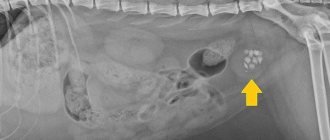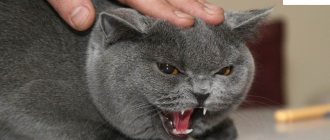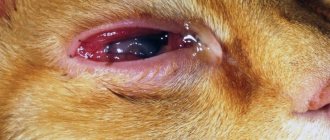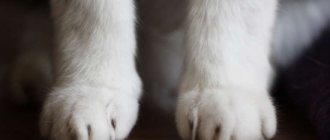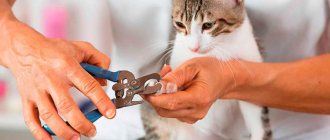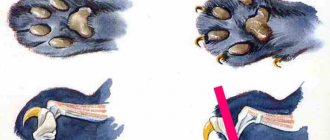A urethrostomy is performed in a cat if stones are stuck in the urethral meatus due to urolithiasis. The essence of the manipulation is to form an artificial urethra to ensure normal urine excretion. Surgical intervention must be carried out in a veterinary clinic by an experienced specialist for existing indications. If urethrostomy is performed incorrectly, there is a high risk of complications that will negatively affect the cat’s future life.
What is the essence of the procedure?
Veterinarians do not advise owners to perform surgery without special indications, since the stoma is difficult to install and heal, painful, and complications often arise.
This treatment involves surgery to create a new passage for the urethra, located between the anus and the scrotum of the cat. If the pet has not been castrated, it will be castrated before urethrostomy. Cystostomy may not be necessary if, in case of urolithiasis, the owners feed the cat properly and give special medications that dissolve the stones.
Late complications
The list of late complications that can arise after surgery is much wider and includes not only accidental pathologies, but also oversights or specialist errors.
Recurrent cystitis occurs in a third of cats undergoing surgery. Very often it is asymptomatic, so animals that have undergone the intervention need to have a urine culture every six months.
To identify the causes of such a complication as dysuria, it is necessary to examine the site of intervention as carefully as possible in search of unremoved sutures. The condition of the urethra is assessed by inserting a catheter into the bladder. If sand blockage is observed, it is removed after irrigation with anesthetics. Urine obtained in this way is tested for bacterial culture. If microflora is detected, a course of antibiotic treatment is necessary. The absence of bacteria indicates a possible cause of dysuria - feline urological syndrome. Despite the fact that in most cases, cat urethrostomy surgery, reviews of which make it possible to independently decide on its rationality, prevents obstruction, it cannot eliminate the possibility of relapse of the syndrome. Persistent dysuria requires a contrast-enhanced radiograph to identify other causes of the disease. These could be tumors, stones, etc.
Stricture is observed quite often. This leads to contamination of the seams. According to various sources, this complication occurs in 12% of cases. Stricture progression can be avoided through careful tissue preparation and absolute attention to surgical technique.
Surgical errors leading to stricture:
- Insufficient dissection of the urethra, in which the bulbourethral glands do not extend beyond the skin. In this case, the tension will very likely lead to deepening of the stoma and further stricture. It is to eliminate such a problem that the pelvic ligaments and muscles must be cut to their full thickness.
- Loose contact of the skin with the urethra. In this case, the wound does not heal for a long time, which is due to primary intention. The tissue produced by secondary intention defeats the purpose of the operation, reducing the diameter of the stoma.
- Incorrect stitching technique. If you do not tighten the sutures very carefully and use a cutting needle, areas of excessive granulation are likely to appear, which in the future can completely block the stoma.
In addition, stricture also appears for non-surgical reasons:
— The occurrence of small ruptures of the urethra obtained during catheterization. Blockage of the urethra after several catheterizations is an indication for prepubic urethrostomy.
— Autotomy occurs when the stoma is damaged by an animal that is not wearing a protective collar.
- Stitches. The ends of the sutures must be long enough so that they are easy to detect by the time they are removed. Forgotten sutures can cause suture granulation.
A minor stricture can be corrected by gentle dilatation with a small clamp. However, most often it is necessary to perform additional surgery. In rare cases, when the urethra is severely injured and strictured, a prepubic urethrostomy is performed.
When is it shown?
The procedure is necessary if the animal has frequent recurrent symptoms of urolithiasis.
If the owners of a pet notice that the cat has difficulty going to the toilet, constantly meows, and when emptying the bladder, a small amount of urine is released, this may indicate urolithiasis. In advanced cases of the disease, stricture (compression) of the urethra is observed, due to which urine is not completely excreted, as a result of which a urethrostomy is required in the cat. Such surgical intervention is required in the following cases:
- repeated symptoms of urolithiasis after drug treatment;
- urethral blockage;
- significant damage to the pet’s genitals;
- urine retention;
- deformation processes in the urethra;
- impossibility of catheterization.
Urethrostomy surgery in cats
For various reasons, the details of the operation change, but the general principles are the same for all diseases.
Before the start of the intervention, control ultrasound and X-ray contrast studies are carried out in order to clarify the location of stones (if any) and the configuration of the urinary tract. After this, antiseptic lavage of the urethra is performed, followed by catheterization. If the animal has not been castrated previously, the procedure is carried out at the beginning of the intervention.
To perform urethrostomy surgery in cats, access to the bladder is provided to remove stones. If there are no pathological formations in the bladder, then its dissection is not necessary. The surgeon makes an incision to access a wide part of the urethra. After this, the penis is removed. At the next stage, the stoma is directly formed by suturing a wide part of the urethra to the skin of the anterior abdominal wall or perineum, depending on the technique.
Features of the preparatory stage
Cystotomy in cats requires special preparation to ensure that the surgery is successful and less painful. If the urethra is narrowed for a long time, then there is a high probability of progression of renal failure, so pre-pubic urethrostomy should be performed urgently. Before surgical intervention, diagnostics are performed, including a number of manipulations, such as:
The list of examinations of the animal before surgery includes an ultrasound examination of the animal's body.
- examination of the abdominal organs using ultrasound waves;
- general and biochemical blood tests;
- laboratory urine tests;
- X-rays of the urinary tract using a contrast agent, performed in the postoperative period.
If, before urethrostomy, concomitant diseases of the genitourinary system or other organs are detected, then the cat must first be treated, and then surgical intervention must be performed. It will be easier for your pet to recover, since the body will not waste resources on fighting other diseases.
What is an obstruction or blockage?
A large number of cats suffer from blocked urinary tract. Usually, even with its obvious symptoms, veterinarians make a diagnosis of ICD in a cat. This plug, which appears in the urethra, may occur due to the fact that sandy mass and various stones or mucus have accumulated there.
Stones that form in the urinary organs have a varied toxic composition of chemical elements. Quite a lot of them can form. They are also completely different in shape.
Surgery scheme
The course of the operation is determined by a specialist after a comprehensive diagnosis of the cat and clarification of the severity of the urolithiasis. After the pet has donated blood and undergone instrumental examinations, a urethrostomy is prescribed, which is performed in several ways:
Most rarely, an animal's stoma is placed in the perineal area.
- Perineal. It is used to correct various types of pathological processes that are observed in the pet’s pelvic floor organs. The technique is used in rare cases, only when the cat does not pass urine through the perineum.
- Prelonnaya. Veterinarians often recommend performing a urethrostomy of this type on cats, during which an artificial stoma is formed. During surgery, simultaneous castration of the male is performed if the owners have not previously performed this procedure. After the operation, the urethra becomes wide and straight, so that sand and stones are easily removed from the body.
How and why urethrostomy is performed
Urethrostomy (urethrostomia - from the words “urethro” and “stoma”, meaning “urethra” and “opening”) is a procedure that allows you to create an artificial channel for the outflow of urine. This opening is called a stoma. The surgeon does it in one of two ways:
- Perineal urethrostomy. The surgeon creates a stoma between the anus and the scrotum. During the operation, the penis and testes are amputated. A catheter is inserted into the resulting hole, which on one side will be located in the urethra, and on the opposite side will extend beyond the abdominal wall. As a result of urethrostomy, a urinary canal is formed that is 2 times shorter than the natural one, but 25–30% wider, so sand and stones with a diameter of up to 5 millimeters can be freely excreted with urine without blocking its outflow.
- Prepubic urethrostomy is more complicated than the previous operation, therefore it is performed in cases where the perineal option is not possible due to contraindications (for example, in case of severe inflammation, tumors in the area of the injured urethra). An incision is made in the peritoneum, in the area of the pubic fusion. The surgeon punctures the bladder to empty it and gain access to the damaged urethra. Then it is removed, and a wide channel is brought out to the site of the abdominal incision.
Urethrostomy is performed under general anesthesia
Postoperative care and rehabilitation
A cat after urethrostomy surgery requires special attention from its owners in order to avoid serious consequences and speed up the recovery process. The pet is put on a special plastic collar so that the animal cannot tear the seam. During rehabilitation, the cat is given disposable diapers, since for some time he is not able to relieve himself in the litter box, as before the urethrostomy. Changing the diaper is required at intervals of 6-8 hours, and also after bowel movements. In this case, the area where bougienage was carried out is treated with antiseptics after each shift. After the operation, follow these rules for a speedy recovery of the cat:
For the next seven days after the intervention, the animal takes the prescribed antibiotic.
- A catheter is inserted into the urethra for 4 days.
- After urethrostomy, the cat remains in the hospital so that veterinarians can monitor his condition.
- If stone removal is successful, then after surgery the pet is injected into the vein with an electrolyte solution and painkillers.
- The pet must undergo an antibacterial course for a week to prevent complications.
- Sutures and stomas are treated several times every day and antimicrobial ointments are applied.
Caring for a cat after urethrostomy
Postoperative care:
- In order to prevent the animal from tearing the stitches, a plastic collar is put on the neck until the surgical wound is completely healed. Also during this period, the cat is put on disposable diapers with a special cross-shaped cut for the tail (you can use regular diapers for children, in which a hole for the tail is cut with scissors). They are changed every 6-8 hours and after defecation. The stoma is treated with an antiseptic every time.
- To alleviate the condition, a urinary catheter is inserted for 3-4 days.
- After urethrostomy, a cat remains in hospital for 1-2 days. At this time, he is given intravenous electrolyte solutions, painkillers and other drugs (as indicated). Antibiotics are administered over 5-7 days.
- Local treatment includes washing the sutures and stoma with chlorhexidine and applying antimicrobial ointments.
Possible complications
Early consequences
Sometimes, even after providing the cat with the necessary care after surgery, negative reactions occur. Among the early complications resulting from urethrostomy are the following:
Sometimes, even under optimal care conditions, an animal develops acute renal failure.
- bleeding;
- manifestation of anuria, due to which urine does not pass for 2 days or more;
- acute course of kidney failure.
Disturbances that occur later
Of particular importance is the rehabilitation of a cat after urethrostomy, which must be observed throughout the entire recovery period. Often after surgery, a cat’s bladder becomes inflamed after some time. Late complications include dysuria, to prevent which it is worth regularly treating the wound and checking the condition of the sutures. If you properly care for your pets after urethrostomy, they will recover and live a normal life.
How does recovery occur after surgery?
After surgery, patients may be kept in the hospital for a few days to make sure they are comfortable and can urinate normally.
To avoid complications, the cat is wearing an Elizabethan collar to prevent licking the surgical site. The Elizabethan collar will need to be worn until the stitches are removed.
When removing stitches, you will need a sedative. It is assumed that after the sutures are removed, patients recover quickly.
Forecast
The overall prognosis after surgery is good, with approximately 90% of clients reporting a satisfactory long-term quality of life.
Perineal urethrostomy minimizes the likelihood of future blockages, but does not cure existing kidney and lower urinary tract diseases.
Are there any contraindications?
If cats have uremic syndrome, then urethrostomy is prohibited. Surgery is performed only after the pet's condition has been stabilized with medication. If blockage of the urethra threatens the life of the animal and catheterization cannot be performed, then the contraindication is excluded and surgery is also performed for uremic syndrome. It is important to understand that bladder surgery is quite traumatic, so it should not be performed if the disease can be cured with medications.
What to do if after urethrostomy the cat does not go to the toilet
In such cases, it is necessary to contact your veterinarian again. The causes of this condition may be remaining large stones or the beginning of closure of the formed hole. In a hospital setting, repeated catheterization is performed for 1-2 days, after which the condition is checked. If there is still no normal urine flow, a repeat operation is necessary.
The price of urethrostomy in a cat depends on many factors - the disease that caused the pathological condition, the age of the cat, concomitant pathologies, and so on. The cost of this procedure in our clinic can be checked with the administrators by calling the clinic numbers.
Why is it dangerous?
If your cat has a large blockage, then as a result, his bladder begins to stretch. As a result of its stretching, all the blood vessels on the walls of the bladder burst. In this case, the blood further enters the animal’s urine. Or vice versa: urine into blood. Due to this, the body is poisoned by various residual chemicals in the urine that should have left it.
As a result of the above processes, pressure in the bladder increases . It spreads higher to the kidneys, affecting them so that they become tense and then hemorrhages occur. Obstruction greatly disrupts the normal functioning of the kidneys, reduces the level of blood circulation in them and negatively affects filtration processes. Urinary retention in the body leads to the development of azotemia. This is a pathology that consists of an elevated level of nitrogenous substances in the blood.
© shutterstock
Through this pathology, uremia develops further. This is self-poisoning of the body, which occurs due to severe impairment of kidney function. If timely surgery is not performed on a cat with urolithiasis, the bladder may rupture.
